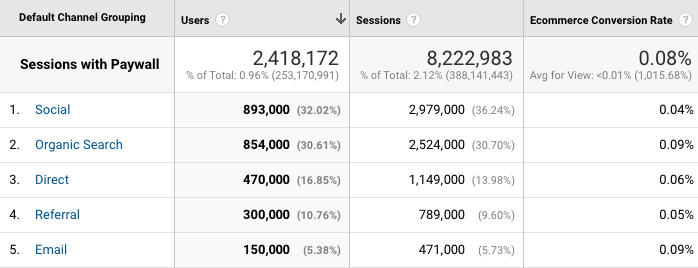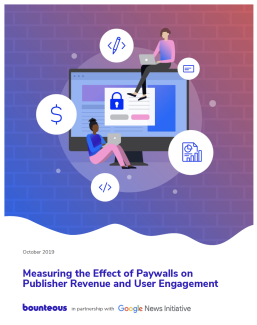Using Measurement to Inform New Revenue Models for Publishers

If you read content on the internet (hello, reader!) then you’ve almost certainly come across publisher paywalls that require user registration or a paying subscriber to access content. As digital publishers have experimented with different revenue models, subscriber-based models have trended upwards, with various techniques and methods implemented to help attract and convert readers into subscribers.
Publishers today need sophisticated analytics implementations that can not only measure engagement metrics like pageviews and engaged time on site, but also can measure eCommerce metrics, conversion rates, and user metrics around subscription status and renewals.
As the landscape changes for publishers, solutions and user experiences are becoming more nuanced and complex. The technical requirements for a publisher are greater than ever, but that also means that the opportunities for improved reader experiences and data-informed decision making are also greater than ever.
Balancing Reader Experience with Revenue
The balancing act that publishers play has only become more complicated over time. Debates over the type of content worth creating date back to before physical newspapers and town criers to art and literature. The ease and speed of digital publishing has changed the type of content created and consumed. Analytics has played a huge role as well, with the ability to measure with certainty which articles received the most traffic, the most shares, the most engagement.
Too deep for this post is the discussion around what makes a ‘good article’ — and which metrics can be used to answer that question. Some sites are more focused on pageviews, which can be translated into a revenue stream by showing ads to the readers. The arguments for and against high-traffic posts remind me of both the reality television boom of the late 1990s and most recently, the Martin Scorsese/Marvel discussion. (Warning: link behind a paywall!)
The debate isn’t new and likely won’t go away, and we’re all familiar with its byproducts: listicles, sensational related articles, 30-page ‘gallery’ articles, etc. For a point of reference, “clickbait” was added to the Merriam-Webster Dictionary in 2015.
Publishers Becoming eCommerce-Focused
As technology and the marketplace has changed, asking readers to pay for content has become more commonplace. A recent study of pay models for online news concluded that over two-thirds of publications have some pay model in place, with 33 percent of the outlets analyzed using some sort of metered or freemium model. As tech becomes easier to implement and as culture norms continue to shift, we’ll likely see greater adoption from smaller and more niche publishers.
For many organizations, this will introduce new and complex measurement and reporting needs. At the most basic, it will be imperative to add the ability to measure purchases — which may be a new concept to many sites. Purchases, in this sense, may represent both paid or free registrations, but come with a signup process and likely a number of choices.
eCommerce measurement with analytics platforms is complex in its scale, as there are so many things that can be measured — promotions, impressions, lists, add-to-carts, checkout funnels, etc. While these reflect technical challenges and effort, they’ll also provide almost limitless opportunity for scrutiny and analysis. Tweaking the user experience can and should be a combination of disciplines to help make the process as seamless and easy as possible. Whether you’re changing the visual design, the user interfaces, or tweaking copy and messaging, these variations can be measured and compared to work towards happier readers and higher subscription rates.
What Marketing Works Best For Publishers?
Attention to marketing best practices and understanding attribution can help narrow down which campaigns and messaging are driving the most engaged readers or helping to increase the number of paid subscribers. Every analytics platform will give metrics about basic traffic statistics like pageview and time on site. Additional work is needed to be able to measure high-quality traffic, like subscribers and converters.
This extra level of detail can help uncover differences in marketing strategies and inform customized campaigns intended to either drive traffic or increase the number of subscribers. Take the example below, which highlights different channels of traffic and their conversion rates, which in this case, is measuring paywall registrations. While some channels are high traffic drivers, like Social in this example, they may not be as successful at bringing in loyal readers that will commit to a subscription.
Amanda Geisler, who helped write our recent publisher playbook on paywall measurement in partnership with the Google News Initiative, stressed the importance of a proper measurement strategy and setup in decision making.
Publishers Need to Focus on Users
There’s always been a need to focus on the readers, but the shift from free content to content behind a paywall also is significant for the introduction of the signed-in user. This is a huge benefit for subscription sites, as signed-in users can help bridge the technical challenges like cross-device usage, private browsing, ad blockers, and more. When someone logs in to a website, their previous sessions can be connected to deliver them a more personalized experience and to inform our analytics about their previous behavior.
This too comes with a measurement challenge, as tools like Google Analytics provide specific features and recommendations around measuring signed-in users. Completing this effort will connect together cross-device sessions, unlocking a number of valuable reports and consolidating into a single viewpoint for a reader.
High Traffic vs High Engagement
Which is better — lots of readers that visit infrequently or fewer readers that are highly loyal? There’s likely not an easy answer to the question, but the shifts to paywalls and metered reading suggest that the industry is trending towards the latter. There are a number of benefits to be realized with this model. Proponents of subscription-based models may argue that publishers are able to focus on longer-form, higher-quality content. What is the threshold of quality or quantity that will entice someone to subscribe or pay for that content?
Adding subscribers may end up changing the balance of revenue. Some publications are largely monetized by advertising, so if a publisher begins actively stopping people from reading their articles — they’ll certainly see a dip in ad impressions and revenue. Ideally, that will be offset by the subscriber revenue, but hitting that perfect balance takes time and tweaking.
At the same time, smaller, niche audiences that are highly loyal can also be extremely attractive audiences to advertisers. Whether packing those audiences up and negotiating directly with advertisers or using a tool like Google Ad Manager, in theory, the process should be a win-win for both publisher-reader. Publishers are able to command a higher price for their audiences and readers will, again, in theory, be delivered more contextually relevant advertising and promotions with more relevant offers.
Looking Ahead For Publishers
The lines between verticals continue to blur. B2B and brand websites now look like publishers, with the focus on content marketing. Publisher sites now look like eCommerce sites, with the hyper-focus on metrics like conversion rates, churn, and more. The technical baselines around measurement and customer experience continue to rise, and digital publishers need to be embracing best practices from their industry as well as established tactics from other verticals in order to remain competitive. Massive amounts of data can be collected and analyzed, and used in the right way like improving experiences, reducing friction, and tailoring messaging, can have a significant impact on future growth.
Bounteous recently created a guide for measuring paywalls and publisher metrics in partnership with the Google News Initiative. Written by Amanda Geisler and based on her recent work with publishers, this playbook outlines the technical steps necessary to measure information about readers, content, and subscription offerings like paywalls.
Read our publisher playbook here: Measuring the Effect of Paywalls on Publisher Revenue and User Engagement




